
For those of us who are used to domesticated dog breeds, it’s hard to think of dogs as wild. But they exist, and there are even several different breeds. With so many different types of wild dogs out there, here are facts about the most common, well-known, or those with extensive habitat ranges, plus facts about big, small, and rare ones. Read on to learn more about the different types of wild dogs from around the world.
African Wild Dog

©iStock.com/Ondrej Prosicky
Also called the African hunting dog, Cape hunting dog, or painted dog, its scientific name (Lycaon pictus) means “painted wolf.” It refers to its mottled fur color pattern. This canine species is native to the grasslands, forests, and deserts of sub-Saharan Africa, and is the only living member of the genus Lycaon. The African Wild Dog is the most efficient hunter of any big predator, with an 80% or higher success rate. Differing from the more common genus Canis, it has highly specialized teeth for a hyper-carnivorous diet and no dewclaws. It is the largest wild canine species in Africa and the second-largest in the world. Prey-wise it targets several species of African ruminants, warthogs, hares, cane rats, and insects. Although now rare, it is one of the most dangerous wild dogs.
Bush Dog

©iStock.com/Christian Decout
A small Central and South American wild canine species, the bush dog is related to the Maned Wolf and the African Wild Dog. It is also the only living species of the genus Speothos. With long, soft, brownish fur and reddish tinges, a bushy tail, and a dark underside, it has short legs, a short snout, and small ears. Like the dhole and the African wild dog, it has a unique dental formula for its carnivorous diet, which consists of all big rodents such as capybaras, agouti, and pacas. It cannot breed with other canids to create fertile hybrids. The three recognized subspecies are the South American bush dog, the Panamanian bush dog, and the southern bush dog. It is one of the most dangerous wild dogs, although it is now rare.
Dingo
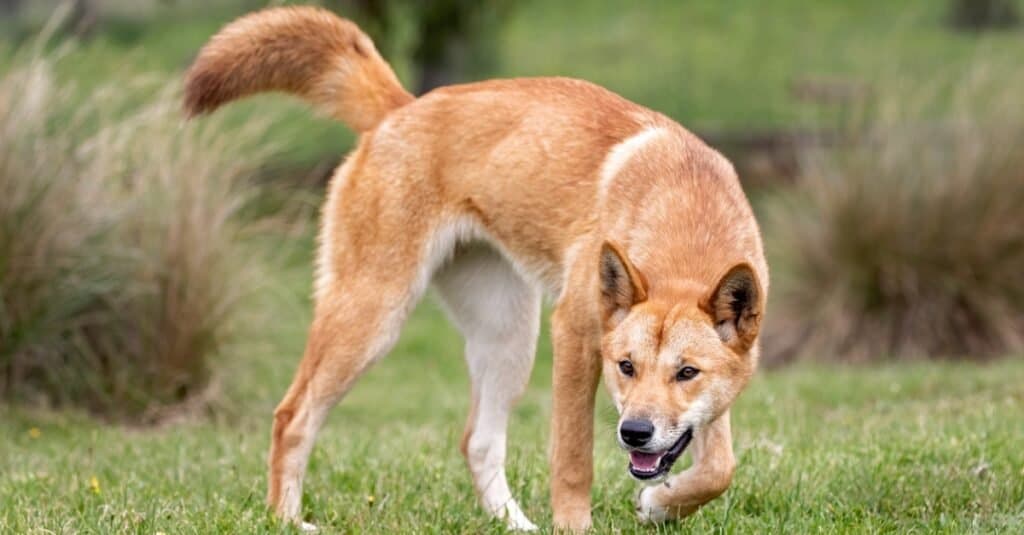
©iStock.com/Andrew Haysom
An ancient dog lineage that is native to Australia, the dingo was introduced to the country by seafarers about 4,500 years ago. Although its scientific name is Canis lupus dingo, its taxonomic classification differs depending on the classification. There is no consensus as to whether it is a wolf, a primitive dog, a missing link between wolf and domestic dog, half-wolf half-dog, or a distinct species. It is also debated whether it is the true ancestor of modern domestic dogs. However, facts about genetic testing show it is related to the New Guinea highland wild dog and the New Guinea singing dog, with its lineage separating early on from that which led to modern domesticated dogs.
This medium-sized canine species has a fur color of cream, black, and tan, or tan, with a big, wedge-shaped head. 80% of its diet consists of wombats, rats, rabbits, possums, kangaroos, wallabies, goose, and cattle. For the indigenous Australians, the dingo was used as camp dogs, living hot water bottles, and hunting aids, with their scalps traded as currency, fur for traditional costumes, and teeth for decoration. Today, it is considered a pest by livestock owners and one of the most dangerous wild dogs. The Shiba Inu is similar to the dingo but whereas the Shiba Inu has been fully domesticated, the dingo has not.
Maned Wolf
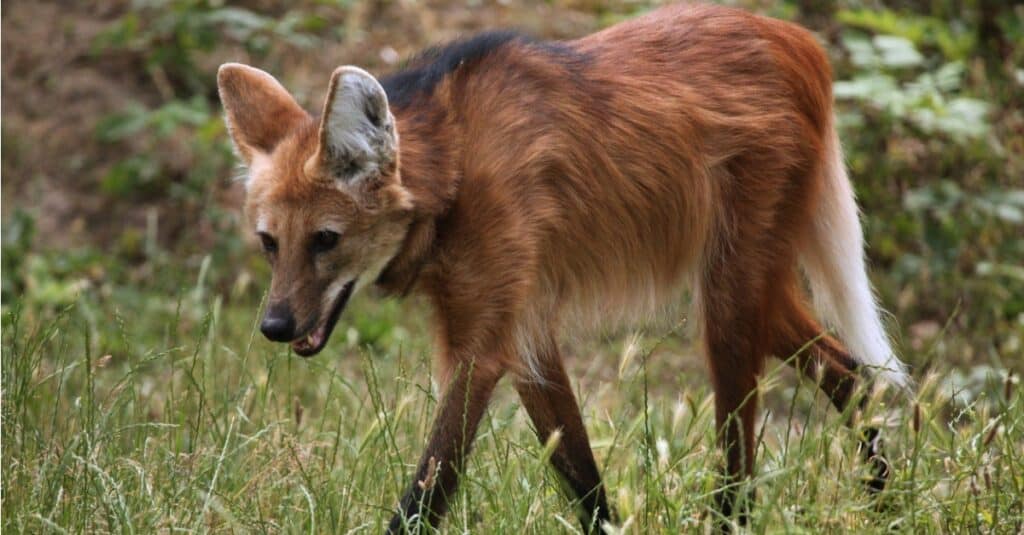
©Vladimir Wrangel/Shutterstock.com
Another South American wild canine species, the maned wolf is actually not a wolf despite its name, and it is not a fox despite its coloring, making it unique. It is the only species of the genus Chrysocyon, which means “golden dog.” It is also the largest species in South America and the tallest in the world. In appearance, it has reddish for, a plumed tail, and long, thin black legs. Like some other wild canine species, it is crepuscular, but its diet is omnivorous rather than carnivorous, eating small and medium-sized animals along with fruit, sugarcane, and tubers. It makes its home in open and semi-open habitats, especially grasslands. The name “maned wolf” refers to the mane on the back of its neck. “Skunk wolf” is its nickname, which refers to the strong odor of its territorial markings. It is now rare.
Red Wolf
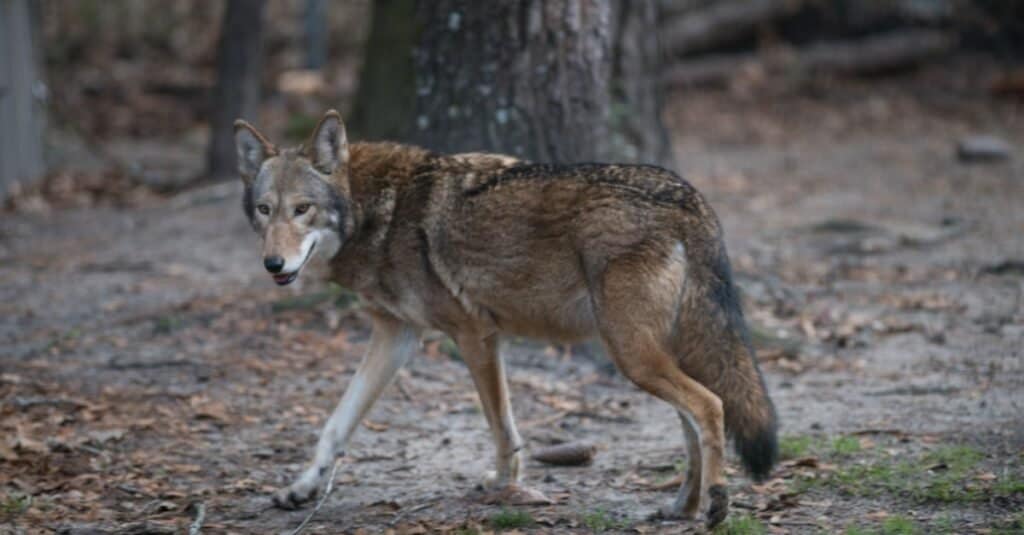
©iStock.com/cmicah
A native of the southeastern United States, the red wolf is a close relative of the eastern wolf. Physically, it is a cross between the grey wolf and the coyote, and there is no consensus on its taxonomic classification. Its original habitat distribution included the south-central United States and the northern United States and it went almost extinct due to crossbreeding with coyotes, habitat loss, and predator-control programs. It is now rare. The wild canine species was an important figure in pre-colonization Cherokee spiritual beliefs, and the Cherokee avoided killing it so as not to anger its pack-mates.
Grey Wolf
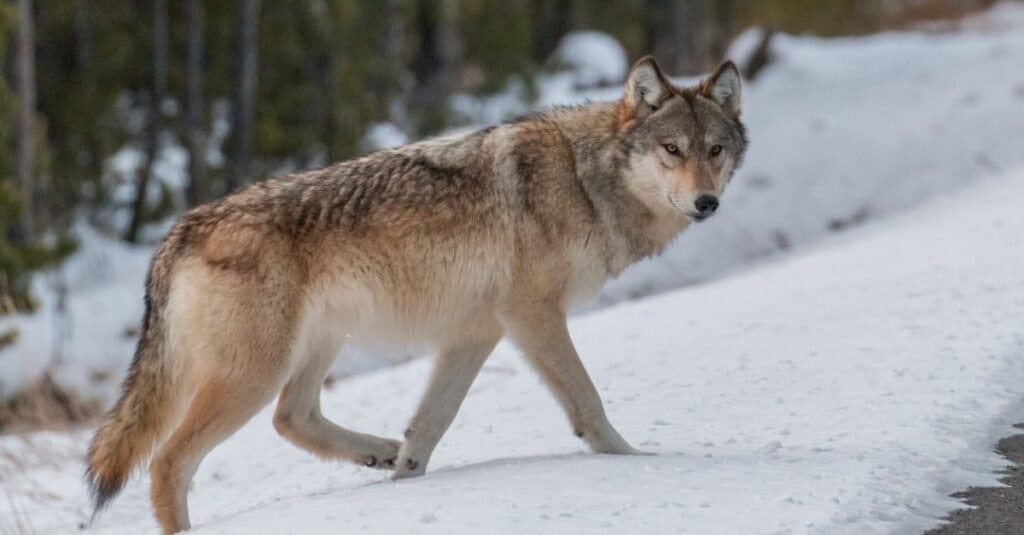
©iStock.com/mtnmichelle
The grey wolf is the wolf’s type species and has over 30 subspecies. It is native to North America and Eurasia. The largest canine species of the family Canidae is known for pack cooperation for hunting big prey, the pack structure of the nuclear family is headed by an alpha male and an alpha female, and being the ancestor of the domestic dog. It is related to the golden jackal and coyote and can crossbreed to create fertile hybrids, such as the coywolf. In contrast, the Mexican wolf is a small species.
Arctic Fox

©iStock.com/MikeLane45
Also called the snow fox, polar fox, or white fox, this wild canine species is native to the Arctic regions where it makes its home in the tundra, living in underground dens. The arctic fox is incredibly adorable and delicate-looking. However, it is tough enough to survive some of the coldest temperatures. Thick, fluffy fur, a fluffy, big tail, and a rounded body provide warmth and prevent loss of body heat, while its white coloring provides camouflage. Its diet is largely carnivorous, with the canine species eating waterfowl, seabirds, fish, ringed seal pups, voles, and lemmings along with carrion, insects, and other small invertebrates, seaweed, and berries.
Red Fox

©iStock.com/William Chua
One of the natural predators of the arctic fox, the red fox is the largest of the true foxes, of which there are 12 species, while the Bengal fox and fennec fox are small. Like other fox species, it lives in underground dens, has whiskers on its face as well as legs, and does not chew its food but tears it into smaller pieces. Dog-like features, a bushy tail, and high-pitched shrieking mating calls make it the most well-known of the foxes. As a nocturnal canine species, its main prey is small rodents, which it catches with a high pounce. It is a common target for pest control, fur, and sport, with its tail being cut off and used as a trophy, called a “brush.”
Jackal
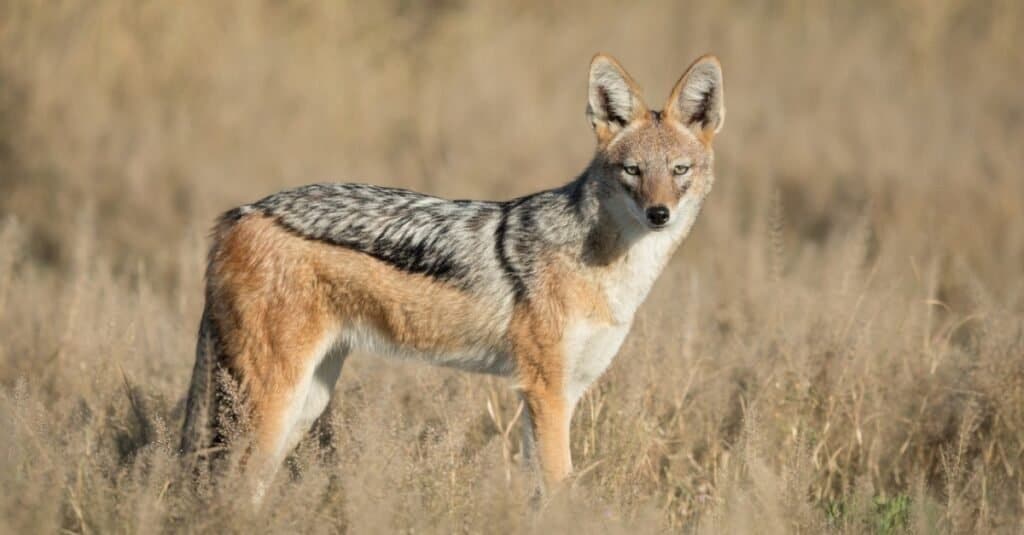
©iStock.com/StuPorts
The word “jackal” refers to either one of three subspecies: the golden or common jackal of Asia and south-central Europe, plus the black-backed or silver-backed jackal and the side-striped jackal of sub-Saharan Africa. The golden jackal lives in arid grasslands, deserts, and open savannahs, the black-backed jackal lives in woodlands and savannahs, and the side-striped jackal lives in mountains, bushland, marshes, and savannahs. The jackal is related to the coyote. It can run up to 9.9 mph.
As a nocturnal predator, it is an opportunistic omnivore and eats small mammals, birds, reptiles, amphibians, carrion, insects, fruit, and plants. Each jackal family has its own yipping sound, with the side-striped jackal being able to hoot like an owl. Like coyotes and foxes, this canine species is not only an opportunistic carnivore but is considered to be clever and magical in myths and legends. It is also in superstitions about death and evil spirits. Used as a literary device, the jackal symbolizes abandonment, loneliness, and desolation.
Coyote
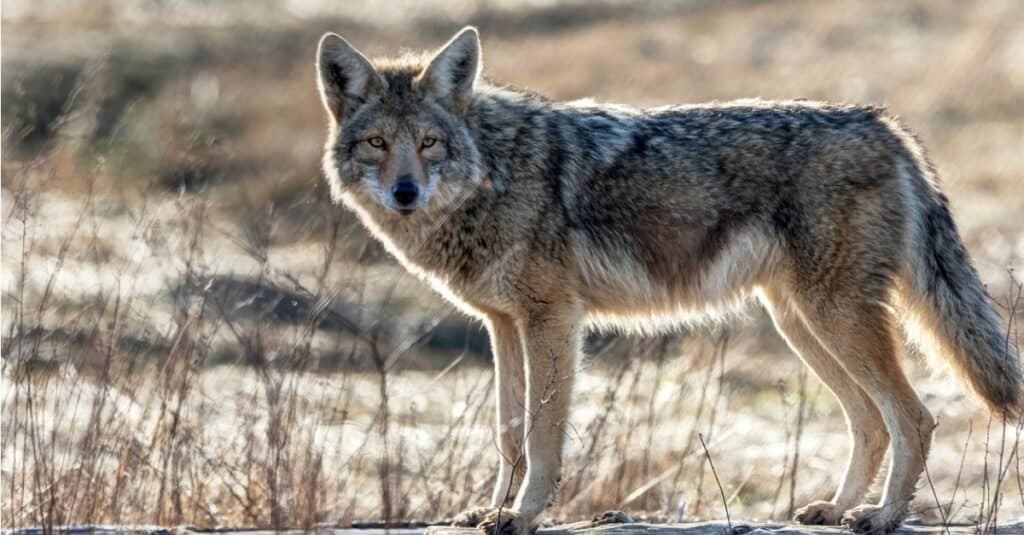
©iStock.com/jamesvancouver
The coyote is a native North American canine species. It is smaller than its relative the wolf, eastern wolf, and red wolf, and larger than the golden jackal. Although it is more predatory than the golden jackal, its ecological niche is very similar. There are 19 recognized subspecies of coyotes. Mostly carnivorous, its diet consists of invertebrates, fish, amphibians, reptiles, birds, rodents, hares, rabbits, and deer, with the occasional fruits and vegetables.
Although grey wolves are among its threats, it sometimes breeds with eastern, red, or grey wolves to produce the coywolf. It also sometimes breeds with dogs to produce coydogs. The name “coyote” comes from an indigenous word meaning “barking dog,” and it does have similar sounds to those of dogs, but about 12 distinct calls. It is a fast runner, able to run up to 40mph, and an excellent swimmer.
Not just living in the wild, it has adapted to urban and suburban areas. Like foxes, it is a pest but can also aid in pest control of rodents. And like wolves, it has similar behavior, such as living in dens. It hunts alone for small prey or in packs for larger prey, going on tiptoe, and sometimes with badgers, which are great diggers to the coyote’s excellent sense of hearing. In Native American folklore, it is a trickster. The snow coyotes of Newfoundland are rare.
Wild Dogs Facts
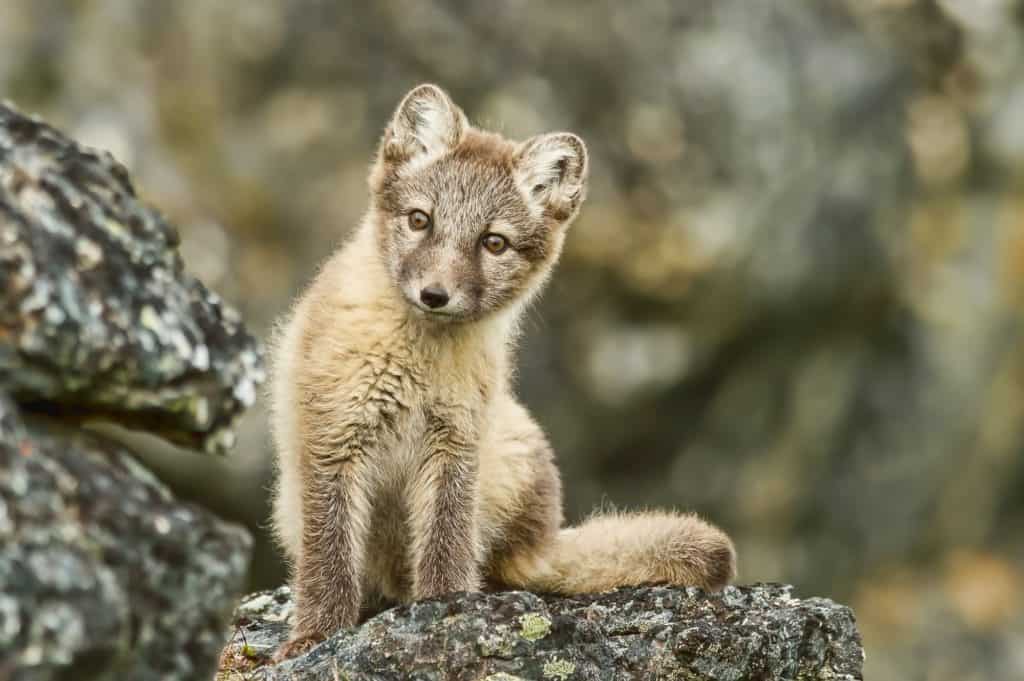
Arctic foxes can live from 7 to 10 years.
©FloridaStock/Shutterstock.com
- Wild dogs are the second most dangerous predators after the big cat family.
- The Honshu Wolf was the world’s smallest wild dog, but it has been extinct since 1905 due to diseases such as rabies.
- The New Guinea Singing Dog exists only in captivity.
- Wild Dogs are nomadic and this lifestyle has not only influenced their critical status, but it also means no nature reserves can comfortably hold them.
- They make strange noises, grin, and bow to each other.
- Their hunting style is to tear their prey apart as a group.
- They generally live in packs of 2 to 10, but up to 40 or more.
- They can run at up to 44mph.
The different types of wild dogs are generally divided into dogs, coyotes, foxes, wolves, jackals, dingoes, and other canids. There tend to be several subspecies of each which differ depending on climate and geography. Some look quite primitive, while others look very similar to our modern pets and working dogs. Even so, they can never be fully domesticated.
What Is The Lifespan of A Wild Dog?
Some species have a shorter life expectancy, such as the African Wild Dog (6 years) and the arctic fox (7 years). A wolf, whether it is red or grey, lives on average 10-12 years, though a maned wolf and dingo can live up to 15 years. Jackals and coyotes also can live up to 15 years. The red fox is the outlier, with an expectancy of 2-4 years in the wild and 10-12 years in captivity.
Is It Normal For Wild Dogs To Attack Humans?
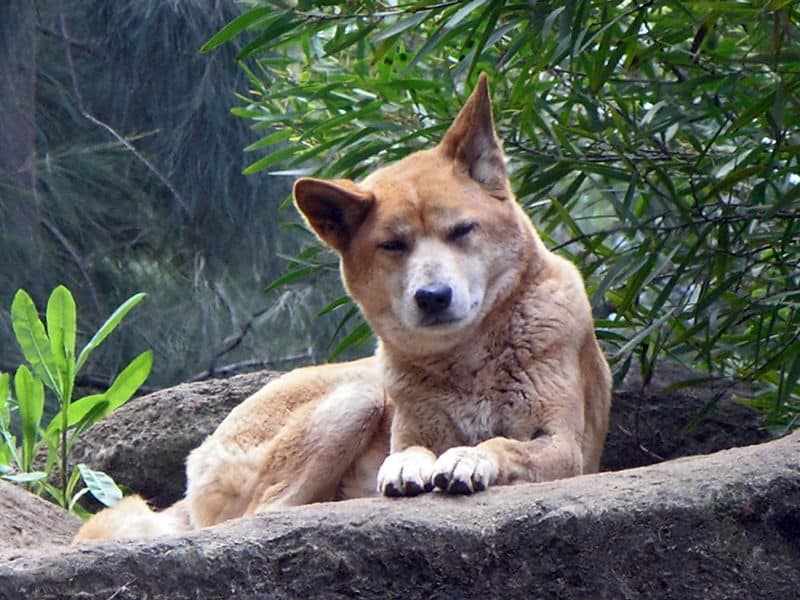
Dingoes are known for their smaller size and great agility and flexibility. They also are great climbers.
©SeanMack, CC BY-SA 3.0, via Wikimedia Commons – Original / License
Wild dogs typically do not attack humans and will not stalk you as prey. Don’t fear, as your children aren’t targeted by these wild dogs, either. However, your smaller outdoor pets might be at risk, especially if a wild dog ventures into suburban areas (think coyotes in California).
This doesn’t mean you shouldn’t be alert and prepared when encountering wild animals. In a desperate situation, some animal packs, like jackals and dingoes, will attack humans, especially small children, though these are rarely fatal. Also, if you happen to venture close to their young or their food source, wild dogs will be more prone to bite.
These wild dogs much prefer your livestock, so if you own sheep, chickens, and the like, keep them safe from attacks.
Who Would Win: Dingo vs Grey Wolf
Though these two wild dogs aren’t typically near each other geographically, it is interesting to compare the two if they were ever to have a chance encounter. Both dingoes and grey wolves are social and smart, capable of problem-solving and maneuvering complex behaviors.
Grey wolves are carnivores, eating meat from smaller animals and sometimes large ones like elk and deer. On the other hand, dingoes are omnivores, eating everything from fruits to invertebrates, to small and large vertebrates. They will also scavenge for food off of carcasses.
Both dingoes and wolves are capable of moving at fast speeds and sustaining them for long periods of time. However, dingoes have the advantage in tight spots, as they are much in smaller size, have greater agility and flexibility, and can climb well. Though in a fight, the wolves are heavier, taller, and longer, with a heavier bite quotient. They also tend to hang out in larger packs, between 10 and 20 wild dogs. Dingoes are often found alone or in very small packs.
If there was an encounter, if the dingo didn’t run away, then they wouldn’t survive a wolf’s attack. A wolf would win.
What Dog Breed Is Closest To A Wolf?

The
Siberian
husky is a distant relative to the wolf. They were originally bred as sled dogs.
©Sbolotova/Shutterstock.com
While domestication of wolves occurred 150,000 years ago, there are several dog breeds that can be traced back to their common ancestor, sharing DNA. Believe it or not, the petite Shih Tzu is close genetically to the wolf. These cute dogs, known for their big eyes and floppy ears, were bred to spend time indoors with Chinese royalty. Even closer in relation to wolves are the Alaskan Malamute and Siberian Husky. Both of these dogs share a similar appearance to the wolf, with their muscular, large stature, pointed ears, and thick fur. Unlike wolves, however, these furry friends are friendly and trustworthy companions to humans.
Summary Of The Different Types Of Wild Dogs
| # | Wild Dog | Distribution |
|---|---|---|
| 1 | African wild dog | Eastern and Southern Africa, particularly Tanzania and Mozambique |
| 2 | Bush dog | South America, especially Amazon Basin |
| 3 | Dingo | Australia |
| 4 | Maned Wolf | South America, especially the Amazon Basin |
| 5 | Red Wolf | North Carolina, U.S. |
| 6 | Grey Wolf | North America, Europe, Asia |
| 7 | Arctic fox | Northern Europe, Northern Asia, and North America |
| 8 | Red Fox | North America, Europe, Asia, Australia |
| 9 | Jackal | Africa, Asia, Europe |
| 10 | Coyote | North America |
The photo featured at the top of this post is © Thomas Retterath/Shutterstock.com
Ready to discover the top 10 cutest dog breeds in the entire world?
How about the fastest dogs, the largest dogs and those that are -- quite frankly -- just the kindest dogs on the planet? Each day, AZ Animals sends out lists just like this to our thousands of email subscribers. And the best part? It's FREE. Join today by entering your email below.
Thank you for reading! Have some feedback for us? Contact the AZ Animals editorial team.







